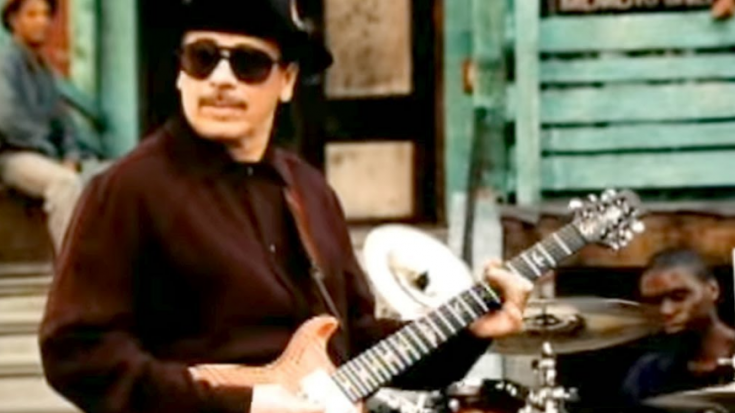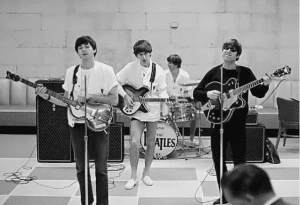We Rank The Best Santana Albums

via Santana / Youtube
Carlos Santana’s music is a vibrant blend of genres, featuring scorching guitar solos and unforgettable compositions. His impact on music is undeniable, with a discography bursting with genre-bending albums that capture the essence of Santana. From high-octane rock to enchanting Latin melodies, these albums solidify his legendary status in the Rock and Roll Hall of Fame.
When discussing the best Santana albums, we dive into the story of a band that practically invented a music genre. Their sound seamlessly blended rock, Latin, jazz, and blues, with each album marking a significant moment in their illustrious career. It’s a testament to their constant evolution that they could move from electrifying soundscapes to more mellowed rhythms, all while retaining their signature Santana flavor.
Take, for instance, Abraxas, a 1970 release that cemented Santana’s place in music history. This album showcased their unique blend of jazz and Latin rock, featuring iconic hits like “Black Magic Woman/Gypsy Queen” and “Oye Como Va”.
Santana III (1971) further demonstrated their versatility, effortlessly weaving together diverse musical styles. This incredible collection also includes Caravanserai, with its smooth transitions between jazz and rock, and the self-titled Santana, their debut album that launched them onto the world stage.
https://twitter.com/213_LA_Sportz/status/1766585629188501771
12. Supernatural (1999)
Santana’s 1999 album Supernatural wouldn’t exist without industry legend Clive Davis. Davis saw hit-making potential in the 52-year-old guitarist, and the results were undeniable. The album boasted two No. 1 singles (“Smooth” with Rob Thomas and “Maria Maria” with The Product G&B), sold 30 million copies, and won a whopping nine Grammys.
Beyond the chart-toppers, Supernatural offered hidden gems. Instrumental tracks like “The Calling” featuring Eric Clapton showcased Santana’s iconic guitar skills, while collaborations like “Love of My Life” with Dave Matthews and “Corazon Espinado” with Maná proved just as captivating as the mega-hits.
11. Africa Speaks (2019)
In a surprising turn of events, Santana approached Rick Rubin for a collaboration in 2019. Rubin, expecting requests for mainstream artists, was surprised by Santana’s choices: Laura Mvula and Concha Buika. Despite the initial uncertainty, Africa Speaks materialized within 10 days, bursting with a vibrant energy and rhythmic complexity that rivaled any Santana album.
While the album debuted strong at No. 3 on the Billboard 200, it quickly faded from the charts. However, for those who discovered it, Africa Speaks became a deeply moving experience, a testament to the enduring power of Santana’s music.
10. Inner Secrets (1978)
Santana’s 1978 album, Inner Secrets, marked a turning point in their sound. Prior to this, their music thrived on Latin rhythms and jazz influences. However, Inner Secrets embraced a more commercially focused approach, aiming for mainstream FM radio success. This shift saw them delve into cover songs, including Traffic’s “The Dealer” and Buddy Holly’s “Well All Right”.
Despite this change, Santana’s energy and talent shone through. The album held its own against other commercially successful releases of the time like Journey’s Infinity and Foreigner’s Double Vision. While later albums continued this commercial push with diminishing returns, Inner Secrets remains a solid listen, showcasing Santana’s adaptability and powerful musicianship.
9. Moonflower (1977)
Spanning two LPs, Moonflower offers a glimpse into Santana’s evolving sound. Live tracks showcase both their mellower direction, evident on earlier releases like Festival, and their undeniable power as a live act. These performances range from recent material to classics from their earliest days, highlighting the band’s transformation over time.
The live energy truly shines on Side Two, where “Dance Sister Dance” ignites movement and “Europa (Earth’s Cry, Heaven’s Smile)” evokes a stadium-sized singalong. The studio recordings add further depth, with the driving bass of “Zulu”, the soulful ballad “Transcendence”, and their Top 30 hit cover of the Zombies’ “She’s Not There”. Moonflower effectively captures both the musical shift and the enduring brilliance of Santana.
8. Santana IV (2016)
Reuniting the core members of Santana III for a new album in 2016 seemed like a gamble. However, Carlos Santana, Neal Schon, Gregg Rolie, Michael Carabello, and Michael Shrieve found magic together once again. Two years of recording yielded a powerful and unexpected return to form.
The album seamlessly blends bluesy jams like “All Aboard” with introspective moments like “Sueños”, where Santana’s acoustic guitar takes center stage. Gregg Rolie’s vocals shine on tracks like “Leave Me Alone” and “Blues Magic”, perfectly capturing the band’s energy. Even guest appearances by Ronald Isley add to the celebratory vibe. While Santana IV might be a bit long at 16 tracks, the album’s strength lies in the band’s undeniable chemistry.
7. Amigos (1976)
Santana took a more accessible approach with Amigos after delving into complex jazz-influenced music on their previous albums. This shift brought back the catchy vocals and vibrant energy of their earlier work. Tracks like “Let Me” groove with funky basslines and keyboard work, while “Gitano” features a call-and-response vocal style reminiscent of hits like “Oye Como Va”. “Tell Me Are You Tired” offers a layered and emotional experience, especially in its driving chorus.
Despite the emphasis on vocals, Amigos doesn’t neglect instrumental brilliance. The album introduced the iconic “Europa (Heaven’s Cry, Earth’s Smile)”, a future live favorite, and “Take Me With You”, which seamlessly transitions from a powerful percussion section to a calmer conclusion. Both tracks rely on Santana’s expressive guitar work and the band’s tight musicianship to convey their emotional depth.
6. Welcome (1973)
Santana’s exploration of jazz-infused rock took a deeper dive with Welcome, following the groundwork laid by Caravanserai. Fueled by Latin rhythms and Carlos Santana’s spiritual awakening, the album prioritized artistic expression over commercial success. Guests like Alice Coltrane and John McLaughlin added their talents, but Welcome is primarily a showcase of Santana’s self-discovery through music.
Tracks like “Mother Africa” feature extended instrumental explorations with powerful drumming by Michael Shrieve. Shrieve’s composition “When I Look Into Your Eyes” is a surprise in itself with a two-minute coda dominated by keyboards and bass, leaving a completely different impression than its opening. Similarly, “Light of Life” incorporates strings for added depth and emotional color. These moments of experimentation and growth elevate Welcome to a place among Santana’s greatest works.
5. Santana (1969)
Riding the high of their electrifying Woodstock performance, Santana released their self-titled debut album in 1969. This record captured the raw energy and virtuosity that captivated the festival crowd. Tracks like “Waiting” and “Savor” pulsate with frantic improvisation, while the genre-defining “Soul Sacrifice” showcases the band’s instrumental prowess.
The album also features the iconic “Evil Ways”, a future classic rock radio staple that reached the Top 10. Finally, “Jingo” lays the groundwork for Santana’s signature sound, fusing African rhythms with Latin influences – a template they’d explore throughout their career. Santana’s debut marked the beginning of a prolific and groundbreaking era for the band and its visionary guitarist.
4. Borboletta (1974)
Among Santana’s fusion-heavy albums of the early and mid-70s, 1974’s Borboletta stands out for its remarkable consistency. Modal structures provide a strong foundation for the album’s twelve tracks, creating a unified listening experience. New vocalist Leon Patillo seamlessly integrates into the band’s sound, his voice functioning as another instrument within the intricate arrangements.
This is immediately evident in “Life Is Anew”, where Patillo blends effortlessly with the percussion and keyboards. “Mirage” showcases Patillo’s talent even further, as his captivating vocal hook drives the entire song. Of course, Carlos Santana’s guitar remains the album’s centerpiece, morphing from jazzy improvisation to more subdued yet powerful rock solos, as exemplified on tracks like “Give and Take”.
3. Caravanserai (1972)
In stark contrast to his later commercially-driven works, Carlos Santana prioritized artistic exploration on his band’s 1972 album, Caravanserai. Taking inspiration from jazz fusion pioneers like Miles Davis and the Mahavishnu Orchestra, Santana steered the band towards a more abstract and nuanced sound. This shift is evident on tracks like “Waves Within”, where the band’s signature Latin groove transforms into intricate sonic textures.
Other highlights include the dynamic ebb and flow of “Look Up (To See What’s Coming)” and the tight interplay on “La Fuente del Ritmo”. While “All the Love in the Universe” hints at a more accessible direction, the album overall marked a turning point. The departure of keyboardist Gregg Rolie and guitarist Neal Schon to form Journey after the Caravanserai tour solidified this shift. Though Santana’s sound would evolve, the artistic freedom explored on this record laid the groundwork for several successful years to come.
2. Santana III (1971)
Santana III marked the final hurrah of the band’s original Woodstock lineup. Carlos would soon begin incorporating new members and exploring a more jazz-driven sound. However, Santana III shines with the raw energy of its core members. The addition of then-teenage guitar prodigy Neal Schon added fire to the band’s sound, evident in tracks like “Toussaint L’Overture”, where their dual guitars soar over a groove-heavy rhythm section.
The album boasts several standouts, including the celebratory anthem “Everybody’s Everything” and the radio hit “No One to Depend On”. Even Carlos himself stepped up to the mic for the uplifting “Everything’s Coming Our Way”, a song that could have easily been another chart-topper. While the future held changes for the band, Santana III remains a collection of their finest moments, capturing the electrifying spirit of their early era.
1. Abraxas (1970)
Abraxas, released in 1970, remains a landmark achievement in both Latin music and rock history. Building upon the promise of their debut, Santana deepens their sound on this iconic record, seamlessly weaving together elements of psychedelic rock, blues, and captivating Latin rhythms.
The album’s bluesy heart is evident in their electrifying rendition of Fleetwood Mac’s “Black Magic Woman” fused with Gabor Szabo’s “Gypsy Queen”, as well as in tracks like “Mother’s Daughter” and the searing guitar solo in “Incident at Neshabur”. This final track hints at the band’s future exploration of jazz, showcasing their mastery of complex time signatures and improvisation.
While Abraxas dives deep into sophisticated musical ideas, it never loses sight of raw power. Tracks like “Se a Cabo” explode with infectious percussion, practically demanding the listener to move. “Hope You’re Feeling Better”, on the other hand, unleashes a powerful blues-rock attack that’s both exhilarating and intense. Through this dynamic journey, Abraxas showcases the immense potential of a young Santana band, poised to leave an undeniable mark on the music world.























